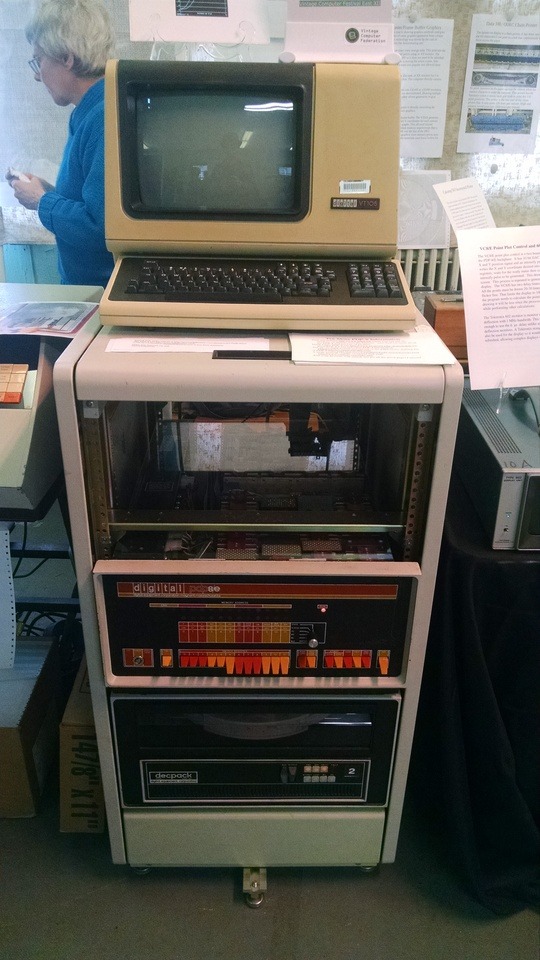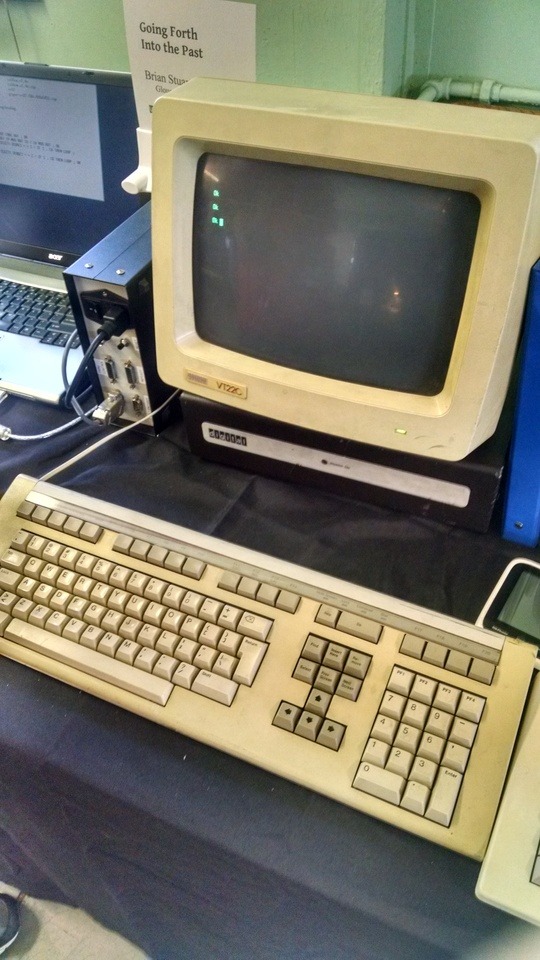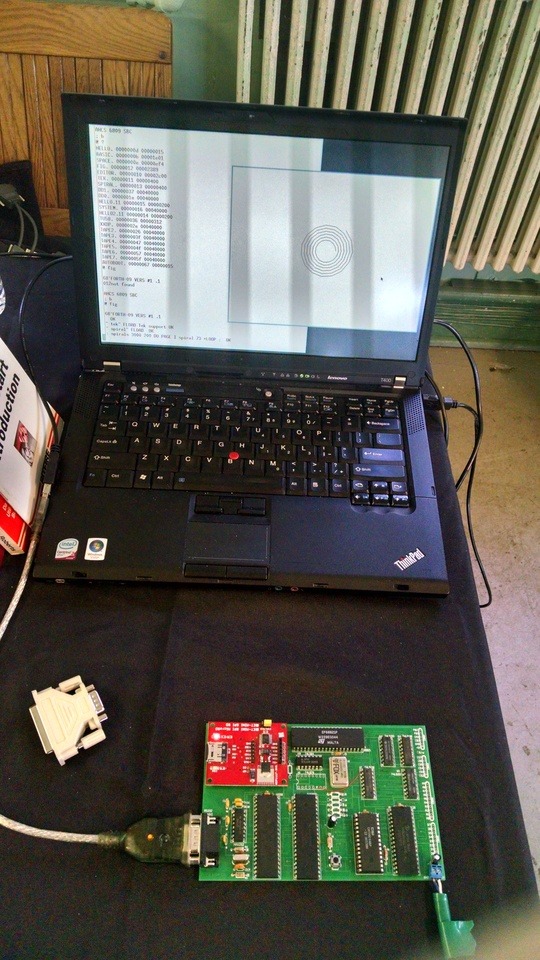#tektronix graphics mode
Explore tagged Tumblr posts
Text







Monty Jaggers McGraw:
I am writing new BASIC programs to demo at my VCF Southwest 2025 exhibit of my 1979 Tektronix 4054A color vector graphics computer.
One of the programs I am writing is a 1978-1979 Battlestar Galactica TV demo. That TV show had $500,000 of Tektronix vector graphics computers and test equipment and many screenshots of their green vector storage CRT displays - some stills - some animated. These computer graphics were generated on both 1975 4051 and 1976 4081 vector graphics computers - predecessors to my 4052 and 4054A computers (see first photo attached).
Miami Herald TV 1978 magazine interview with the Battlestar Galactica set designer indicated extras on the set stationed in front of the 4051 computers were playing games during filming to increase realism and were so absorbed they kept playing after the cut! (article page attached).
The 4051 and second generation 4052 were the same physical size and used the same CRT and same Display board, but the 4052 and 4054 computers replaced the 800KHz Motorola 6800 CPU with a custom four AMD2901 bit-slice CPU to create a 16-bit address and data bus ALU which emulated the 6800 opcodes and added hardware floating point opcodes to speed up these computers 10x over the Motorola 6800, doubled the BASIC ROM space to 64KB and doubled the RAM space to 64KB!
I created these vector bitmap graphics using a "3D CAD" picture I found on the web of the Battlestar Galactica (last attachment).
As far as I know - there was never any 4050 BASIC program to view bitmap pictures on any of the 4050 computers. The 1979 4014 vector graphics terminal had a grayscale bitmap mode in the Extended Graphics option board, but I have only found a couple of bitmap 4014 images on a single Tektronix demo tape cartridge.
My 4050 BASIC program to display bitmaps works on all 4050 series computers - with an optional Tektronix 4050R12 Fast Graphics/Graphics Enhancement ROM Pack. This ROM Pack speeds up displaying vector images (including vector dot images) 10x over using BASIC MOVE and DRAW commands.
The Battlestar Galactica bitmap image in R12 binary format is 332234 bytes - slightly larger than would fit on a DC300 quarter-inch tape cartridge in the internal tape drive of all three 4050 computers, but would have fit on a 3M DC600 tape cartridge with a capacity of 600KB - it would have been very slow to load.
I designed an Arduino board to emulate the Tektronix 4924 GPIB tape drive - with the help of my software developer. My GPIB Flash Drive board contains a MicroSD card with gigabytes of storage and the Flash Drive emulates a GPIB tape changer, storing all the files of a "tape" in a single directory. I have also attached to this post a photo of my GPIB Flash Drive.
I have recovered almost 100 Tektronix 4050 Tapes and posted the ones I think are the most interesting at this time on my github repository for Tektronix 4051/4052/4054 computers: https://github.com/mmcgraw74/Tektronix-4051-4052-4054-Program-Files I included Tektronix published MATH volumes 1, 2, and 3 and Electrical Engineering, but I don't think they have a lot of use today. I have in my collection but not recovered tapes on Project Management, Statistics, and over 100 more tapes from the very active user group, which Tektronix made collections and published abstracts in their newsletter and the newletter customer got the tape for free. Commercial software like CAD programs were likely encrypted to eliminate copying - since Tektronix 4050 BASIC included a SECRET command which would then encrypt the program file as it was recorded to tape and add a SECRET flag in the tape header that would signal to BASIC ROM when that file was accessed to decrypt the program when it was loaded into memory. One big limiter to the size of the program was RAM in the 4051 was limited to 32KB and the 4052 and 4054 were limited to 64KB of RAM, although Tek BASIC did include commands to allow program "chunks" to be overlayed as necessary. Tektronix used those commands in their 4050 System Tape which was shipped with every system and included a tutorial on many of their BASIC commands. The tutorial ran on the original 4051 with 8KB of memory, and if the program detected 16KB of memory it would APPEND larger program files to speed up the tutorial.

15 notes
·
View notes
Photo









Pre-Raster Graphics
David Gesswein is considered to be one of the reigning experts in DEC’s PDP-8. Almost every time I’ve been to a VCF East, David is there with a PDP-8 of some kind, usually an 8/e, and this time was no exception. He took portraits with a modern camera, then converted them to ASCII and printed them out on a large, beautiful, dot-matrix printer -- I plan on framing mine!
There was also a Tektronix 4014 showing just how much resolution the 1970s had to offer (if only in monochrome). Brian Stuart, who had the exhibit on Forth, borrowed this terminal to test one of his programs on the authentic piece of kit and it was beautiful. If I understand correctly, unlike other terminals of the era, Tektronix graphical terminals had on-board storage to keep images locally. You’ll note the bank of circuit boards that sat in the cabinet under the CRT to facilitate storage and precision graphical rendering.
Lastly, David had a really cool Calcomp 563 plotter drawing really cool artwork, one line at a time. Makes me want a plotter...
“Multiple graphics technologies will be exhibited that were common before raster graphics won. See 4K graphics on a 1970s Tektronix 4014 vector storage terminal. Have your picture taken by a PDP-8 computer and printed on a 200 line-per-minute chain printer in glorious ASCII art. See a pen plotter operate.”
#vintage computer festival east xii#commodorez goes to vcfexii#VCF East XII#vcfexii#vintage computer federation#pdp-8#pdp 8#pdp-8/e#digital equipment corporation#digital#DEC#plotter#tektronix graphics mode#tektronix
308 notes
·
View notes
Photo








Going Forth Into the Past
You want to find a higher level language that’s really easy to port to various architectures spanning about 50 years? Brian Stuart has you covered with the classic language Forth. Brian even implemented it himself for his LSI-11 (basically a PDP-11/03 on a chip) back when he was in college, and decided to dust it off for the first time in decades just for VCF East. He also had a 6809 based SBC, a SPARC Station, and the Pocket Chip arm based machine. You name it, Forth will be there. He even was emulating a Tektronix graphics terminal on his laptop, drawing spirograph-like images using Forth -- he later got to test it on the real thing.
“In the late 1960s Charles Moore developed the Forth programming language as a tool for efficiently developing control systems. Ever since, it’s found application in domains ranging from tiny embedded systems, to monitoring sorting belts at FedEx, to implementing workstation consoles, to controlling large telescopes, to controlling large laser arrays doing fusion research. Like LISP before it, Forth developed an avid following of programmers who understood how to use it as a meta-language for creating application specific languages customized to the problem at hand. It has a direct connection to the theory of Turing completeness and is one of the simplest languages to implement. This exhibit celebrates this amazing language by demonstrating several different implementations of Forth on a variety of hardware, all accompanied by educational material to help the viewer understand that concepts behind the language.”
#VCF East XII#vcfexii#commodorez goes to vcfexii#vintage computer festival east xii#vintage computer festival east#forth#pdp 11#lsi 11#pocket chip#6809#sparc#digital equipment corporation#tektronix graphics mode
188 notes
·
View notes